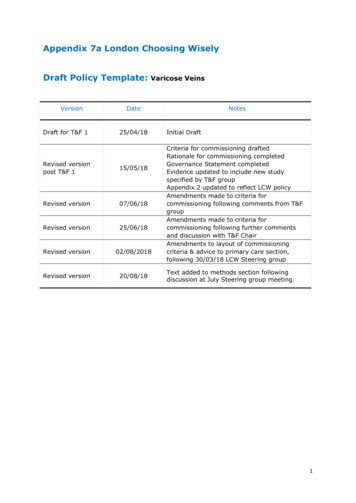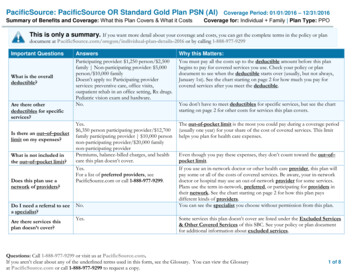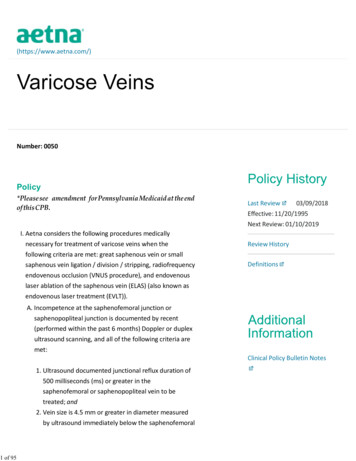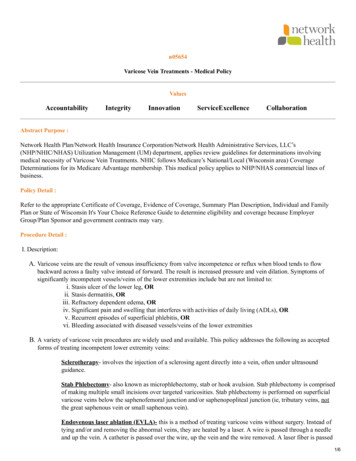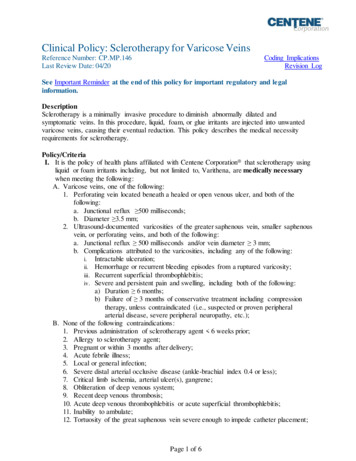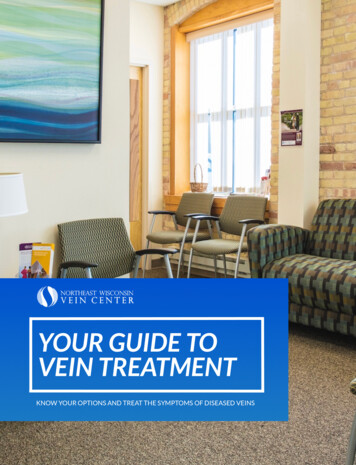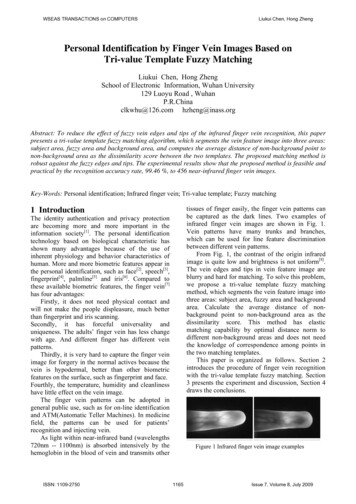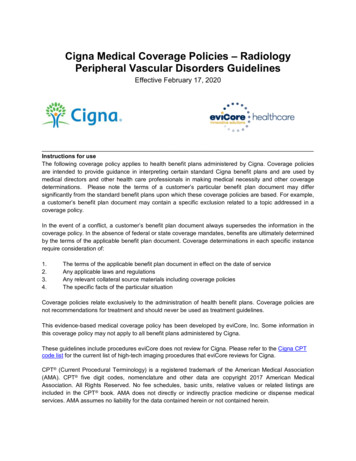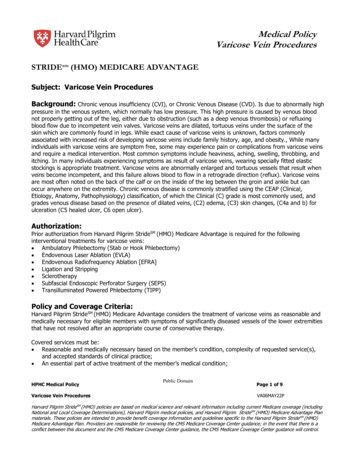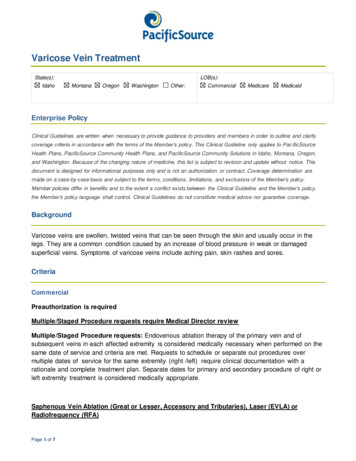
Transcription
Varicose Vein tonOther:CommercialMedicareMedicaidEnterprise PolicyClinical Guidelines are written when necessary to provide guidance to providers and members in order to outline and clarifycoverage criteria in accordance with the terms of the Member’s policy. This Clinical Guideline only applies to Pac ificSourceHealth Plans, PacificSource Community Health Plans, and PacificSource Community Solutions in Idaho, Montana, Oregon,and Washington. Because of the changing nature of medicine, this list is subject to revision and update without notice. Thisdocument is designed for informational purposes only and is not an authorization or contract. Coverage determination aremade on a case-by-case basis and subject to the terms, conditions, limitations, and exclusions of the Member’s policy.Member policies differ in benefits and to the extent a conflict exists between the Clinical Guideline and the Member’s policy,the Member’s policy language shall control. Clinical Guidelines do not constitute medical advice nor guarantee coverage.BackgroundVaricose veins are swollen, twisted veins that can be seen through the skin and usually occur in thelegs. They are a common condition caused by an increase of blood pressure in weak or damagedsuperficial veins. Symptoms of varicose veins include aching pain, skin rashes and sores.CriteriaCommercialPreauthorization is requiredMultiple/Staged Procedure requests require Medical Director reviewMultiple/Staged Procedure requests: Endovenous ablation therapy of the primary vein and ofsubsequent veins in each affected extremity is considered medically necessary when performed on thesame date of service and criteria are met. Requests to schedule or separate out procedures overmultiple dates of service for the same extremity (right /left) require clinical documentation with arationale and complete treatment plan. Separate dates for primary and secondary procedure of right orleft extremity treatment is considered medically appropriate.Saphenous Vein Ablation (Great or Lesser, Accessory and Tributaries), Laser (EVLA) orRadiofrequency (RFA)Page 1 of 7
Endovascular laser saphenous vein ablation may be indicated when ALL of the following criteriaare present:o Duplex ultrasound or Doppler study confirms significant reflux of the incompetent veinexceeding 0.5 seconds ando Vein size is 4.5 mm or greater in diameter measured by ultrasound immediately below thesaphenofemoral or saphenopopliteal junction (not valve diameter at junction)o Saphenous venous insufficiency symptoms causing functional impairment, indicated by 1 ormore of the following: Leg edema Leg fatigue Leg pain requiring chronic daily analgesics medication Persistent or recurrent superficial thrombophlebitis Persistent or recurrent venous stasis ulcero No clinically significant lower extremity arterial diseaseo No deep venous thrombosis on duplex ultrasound or other imaging testo No significant symptomatic improvement in response to 3-month or longer trial ofcompression stockings when patient is able to wear them.The accessory saphenous vein ablation may be indicated when the following are present:oooAforementioned endovascular laser vein ablation criteria are metPersistent junctional reflux is demonstrated after GSV or SSV have been removed orablated by EVLA or RFA at the saphenofemoral junction or saphenopopliteal junctionAt least 3 months have passed since prior treatmentPerforator Veins:Perforator veins connect superficial veins to deep veins. They contain one-way valves to direct theblood from the superficial system to the deep system and are generally 3mm in their normal state.Preauthorization is requiredTreatment of incompetent perforator veins, including surgical ligation (including subfascialendoscopic perforator surgery), endovenous radiofrequency or laser ablation, may be consideredmedically necessary when ALL of the following conditions have been met: Diagnosis of chronic venous insufficiency leg ulcer(s)Perforator reflux per recent ultrasound of 0.5 seconds and vein diameter equal to or greaterthan 3.5mmThe saphenous veins (greater, lesser, or accessory saphenous and symptomatic varicosetributaries) have been previously eliminatedSymptoms have not resolved following combined superficial vein treatment and compressiontherapy for at least 3 monthsThe venous insufficiency is not secondary to deep venous thromboembolism.Note: Ligation or ablation of incompetent perforator veins (of greater, lesser, or accessory saphenousand symptomatic varicose tributaries) performed concurrently with saphenous venous surgery is notcovered. Saphenous venous surgery should eliminate related perforator veins and therefore concurrentligation or ablation of incompetent perforator veins is not considered medically necessary.Treatment of incompetent perforator veins using any other techniques than noted above are consideredinvestigational, including, but not limited to: SclerotherapyStab avulsionPage 2 of 7
Stab/Hook/Micro-phlebectomyTransilluminated powered phlebectomy (TIPP)Ambulatory Phlebectomy:Preauthorization is required.A. Ambulatory phlebectomy performed at the same time as surgical, laser or radiofrequency treatmentof saphenous vein varicosities: The utilization reviewer may consider ambulatory phlebectomymedically necessary when the medical necessity criteria for the primary procedure is met.B. Ambulatory phlebectomy performed as a stand-alone treatment: The utilization reviewer mayconsider ambulatory phlebectomy to be medically necessary when ALL of the following conditions aremet:1. The member's has 1 or more of the following symptoms:a. Moderate to severe pain interfering with activities of daily living and requiring chronicanalgesic medicationb. Severe dermatitis or ulcerationc. Two or more episodes of superficial thrombophlebitisd. Two or more episodes of bleeding2. There is documentation that the member's symptoms have remained unimproved after 12weeks of conservative measures such as exercise, compression hose and elevation.Sclerotherapy:Preauthorization is required using the following MCG Guidelines:Sclerotherapy, Leg Veins, including use of Varithena ACG: A-0170 (AC)Sclerotherapy Plus Ligation, Saphenofemoral Junction ACG: A-0171 (AC) If sclerotherapy is performed in conjunction with the EVLA or RFA Saphenous Vein theutilization clinician can approve following the MCG criteria for sclerotherapy.Sclerotherapy with incompetent perforators is considered experimental, investigational orunproven.Stab Phlebectomy for Vulvar/Labial Varicosities:Stab phlebectomy may be considered medically necessary as a treatment for vulvar/labial varicosities(aka pelvic vein incompetence) when ALL of the following conditions are present: Member has persistent symptoms/signs of discomfort, aching, throbbing, heaviness and/or dullpain which has been present for a least 6 months; andMedication management for at least 3 months has not improved above symptoms (i.e.,medroxyprogesterone or gonadotropin-releasing hormone agonists).Telangiectasia:Page 3 of 7
Treatment by any method of small telangiectasia such as spider veins (1mm or less), superficialreticular veins (1-2mm), angiomata, and hemangiomata is considered cosmetic. Cosmetic treatment isa contract exclusion.Experimental /Investigational /UnprovenThe following are considered Experimental/Investigational/Unproven by PacificSource:Mechanochemical Ablation (MOCA) (e.g., ClariVein Occlusion Catheter, Nonthermal Vein AblationSystem) is investigational for all veins. (no specific code, 37799)VenaSeal Closure Delivery system is considered experimental/investigational/unproven.Anatomy ReferenceMedicaidPacificSource Medicaid follows Oregon Health Plan (OHP) Oregon Administrative Rules (OARs) 410141-3820 to 3825, 410-120-1200, and line number 379 of the OHP Prioritized List of Health Servicesfor coverage of Varicose Vein Treatment.MedicarePacificSource Medicare uses Local Coverage Determination L34010 for Treatment of Varicose Veins ofthe Lower Extremities.Page 4 of 7
DefinitionsAccessory saphenous veins – Travel in parallel with the greater and lesser saphenous veins and aregenerally 2 - 2.5 mm in their normal state.Greater/long saphenous veins – Superficial vein running the entire length of the leg and is generally 3mm in its normal state. A typical GSV contains an average of 7 valves throughout its entire length, andit is the most common superficial vein to develop venous reflux.Lesser/short saphenous veins – Superficial vein of the calf and is generally 2.5 mm in its normalstate. The small saphenous vein originates at the back of the ankle near the outer malleous bone, andusually runs up the back of the lower leg to the popliteal vein behind the knee.Moderate to severe reflux – In current practice, most vascular laboratories consider the presence ofvenous flow reversal for greater than 0.5 second with proximal compression, Valsalva maneuver, ordistal compression and release to represent pathologic reflux.Perforator veins – Connect superficial veins to deep veins. They contain one-way valves to direct theblood from the superficial system to the deep system and are generally less than 3mm in their normalstate.Stab avulsion - This technique is also known as stab/hook phlebectomy. Stab avulsion results inremoval of the varicose veins through incisions that are 2-3 mm in length. The veins are hooked with atiny hook-like instrument and pulled out. The wounds are closed with tapes, not sutures, and the leg iswrapped in elastic compression support. Once healed, the incision sites are almost invisible.Telangiectasia/Spider veins – Very small ( 1 mm in diameter) thread veins found commonly justunder the surface of the skin, usually not distorting skin or surrounding tissues.Tributary Veins—Veins that empty into a larger veinCoding InformationThe following list of codes are for informational purposes only and may not be all-inclusive.Deleted codes and codes which are not effective at the time the service is rendered may not be eligiblefor 473Page 5 of 7Inject non-compounded foam sclerosant w/US compress maneuvers to guide dispersion ofinjectate inclusive of all img guidance & monitoring; single incompetent extrem truncal veinsInject non-compounded foam sclerosant w/US compress maneuvers to guide dispersion ofinjectate inclusive of all img guidance & monitoring; multi incompetent truncal veinsSingle or multiple Injections Sclerosing Solutions, spider Veins; Limb/TrunkSingle or multiple injections of sclerosing solutions, spider veins (telangiectasia); faceInjection of sclerosing solution; single veinInjection of sclerosing solution; multiple veins, same legEndovenous ablation therapy of incompetent vein, extremity, inclusive of all imagingguidance and monitoring, percutaneous, mechanochemical; first vein treated
3773537760377613776537766377803778537799Endovenous ablation therapy of incompetent vein, extremity, inclusive of all imagingguidance and monitoring, percutaneous, mechanochemical; sub vein treated in a singleextremityEndovenous ablation therapy of incompetent vein, extremity, Inclusive of all imagingguidance and monitoring, percutaneous, radiofrequency; first vein treatedEndovenous ablation therapy of incompetent vein, extremity, Inclusive of all imagingguidance and monitoring, percutaneous, radiofrequency; second and subsequent veinstreated in a single extremity, each through separate access sites (list separately in additionto code for primary procedure)Endovenous ablation therapy of incompetent vein, extremity, Inclusive of all imagingguidance and monitoring, percutaneous, laser; first vein treatedEndovenous ablation therapy of incompetent vein, extremity, Inclusive of all imagingguidance and monitoring, percutaneous; second and subsequent veins treated in a singleextremity, each through separate access sites (list separately in addition to code for primaryprocedure)Vascular embolization or occlusion, inclusive of all radiological supervision andinterpretation, intraprocedural roadmapping, and imaging guidance necessary to completethe intervention; venous, other than hemorrhage (e.g., congenital or acquired venousmalformations, venous and capillary hemangiomas, varices, varicoceles)Vascular endoscopy, surgical, with ligation of perforator veins, subfascial (SEPS)Ligation and division of long saphenous vein at saphenofemoral junction, or distalinterruptionsLigation, division and stripping, short saphenous veinLigation, division and stripping, long (greater) saphenous vein from saphenofemoraljunction to knee or belowLigation and division and complete stripping of long or short saphenous veins with radialexcision of ulcer and skin graft and/or interruption of communicating veins of lower leg, withexcision of deep fasciaLigation of perforator veins, subfascial, radial (Linton type), including skin graft, whenperformed, open, 1 legLigation of perforator vein(s), subfascial, open, including ultrasound guidance, whenperformed, 1 legStab phlebectomy of varicose veins, one extremity; 10-20 stab incisionsStab phlebectomy of varicose veins, one extremity; more than 20 incisionsLigation and division of short saphenous vein at saphenopopliteal junction (separateprocedure)Ligation, division, and/or excision of varicose vein cluster(s), 1 legUnlisted procedure, vascular surgery (is utilized for phlebectomy “less than 10 incisions”)CPT codes, descriptions and materials are copyrighted by the American Medical Association (AMA).ReferencesCyanoacrylate Embolization (VenaSeal Closure System) for the Treatment of Varicose Veins. (2019,October 31). Hayes, a Division of htb.venaseal4673Gavrilov, S. (2017, June 28). Vulvar varicosities: diagnosis, treatment, and prevention. National Centerfor Biotechnology Information. PubMed Central. US National Library of /PMC5500487/Page 6 of 7
Kim JW, et.al. Outcome of transilluminated powered phlebectomy for varicose vein: review of 299patients (447 limbs). Surg Today. 2013 Jan;43(1):62-6. Accessed 3/5/2018, 1/29/2019, 11/25/2019,6/01/2020. u G., Slazar, G. Prabhaker, A., & Gangulis, S. (2016, December 6.) Minimally invasivetreatments for perforator vein insufficiency. National Center for Biotechnology Information. PubMedCentral. US National Library of /PMC5220201/MCG Ambulatory Care 24th Edition. Ovarian and Internal Iliac Vein Embolization ACG: A-0567 (AC).MCG Ambulatory Care 24th Edition, Sclerotherapy, Leg Veins ACG: A-0170 (AC)MCG Ambulatory Care 24th Edition Sclerotherapy Plus Ligation, Saphenofemoral Junction ACG: A0171 (AC)MCG Ambulatory Care 24th Edition Saphenous Vein Ablation, radiofrequency ACG: A-0174 (AC)MCG Ambulatory Care 24th Edition Saphenous Vein Ablation, laser ACG: A-0425 (AC)MCG Ambulatory Care 24th Edition Stab Phlebectomy, ACG: A-0735 (AC).Polidocanol Endovenous Microfoam (Varithena) 1% for Treatment of Varicose Veins. (2019, September16). Hayes, a Division of TractManager. 3187Randall WF, et.al. Treatment of Varicose Veins by Transilluminated Powered Phlebectomy Surgery: A9-Year Experience. Int J Angiol. Dec 2012; 21(4): 201–208. Accessed July 13, 2017, March 5, 2018,January 29, 2019, November 25, 2019, PMC3578615/Tisi, P. Varicose Veins. Clinical Evidence 2011. [online publication]: Jan 5, 2011. Accessed 5/3/13,7/13/2017, March 5, 2018, January 29, 2019, November 25, 2019, June 1, 17733/Vandy, F and Wakefield T. Varicose Veins: Evaluating Modern Treatments, With Emphasis on PoweredPhlebectomy for Branch Varicosities. Interventional Cardiology. 2012; 4(5):527-536. Accessed March 5,2018, January 29, 2019, November 25, 2019, June 1, es.htmlWeiss, R. Varicose Veins and Spider Veins Clinical Presentation. Medscape, November 14, 2012.Accessed 5/3/13, July 13, 2017, March 5, 2018, January 29, 2019, November 25, 2019, June 1, overview.AppendixEffective: 10/1/2020Policy type: EnterpriseAuthor(s): PD 11/5/2020Depts: Health ServicesPage 7 of 7Next review: 10/1/2021
it is the most common superficial vein to develop venous reflux. Lesser/short saphenous veins - Superficial vein of the calf and is generally 2.5 mm in its normal state. The small saphenous vein originates at the back of the ankle near the outer malleous bone, and usually runs up the back of the lower leg to the popliteal vein behind the knee.
